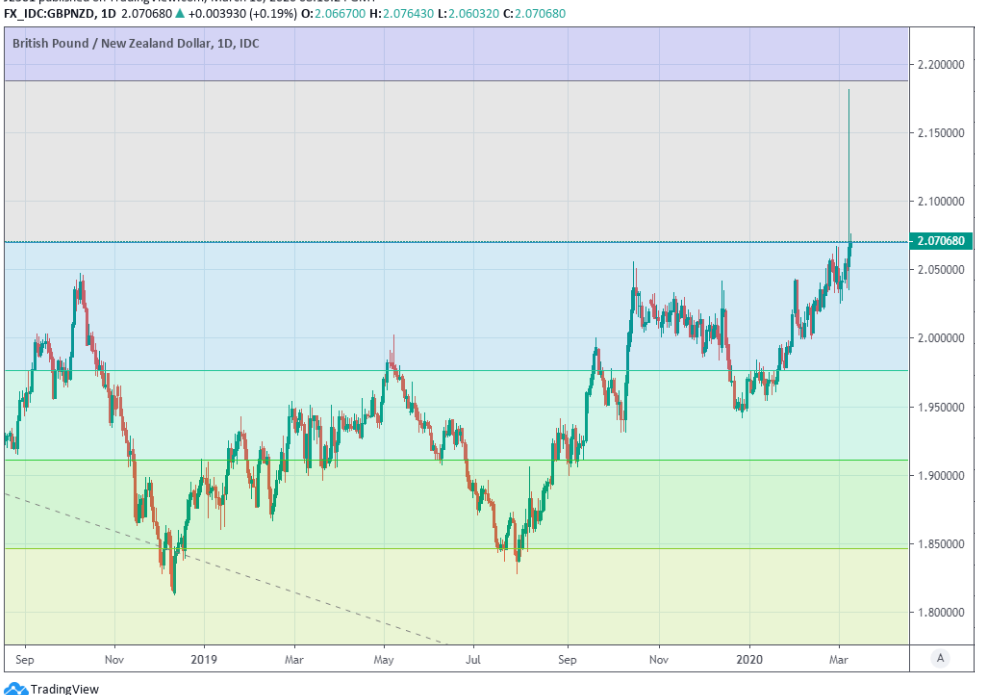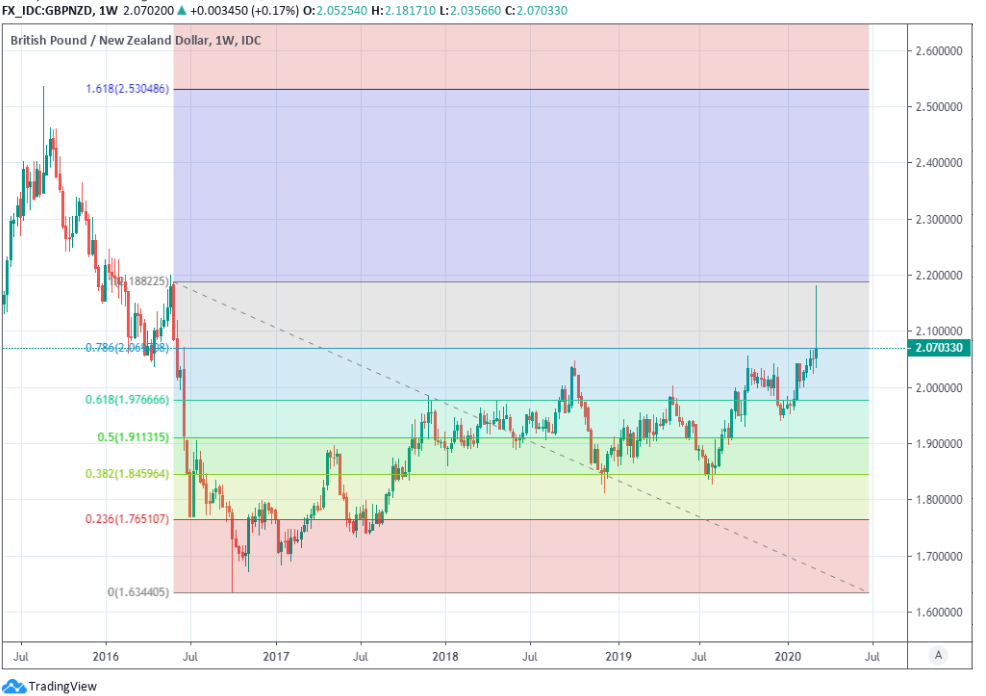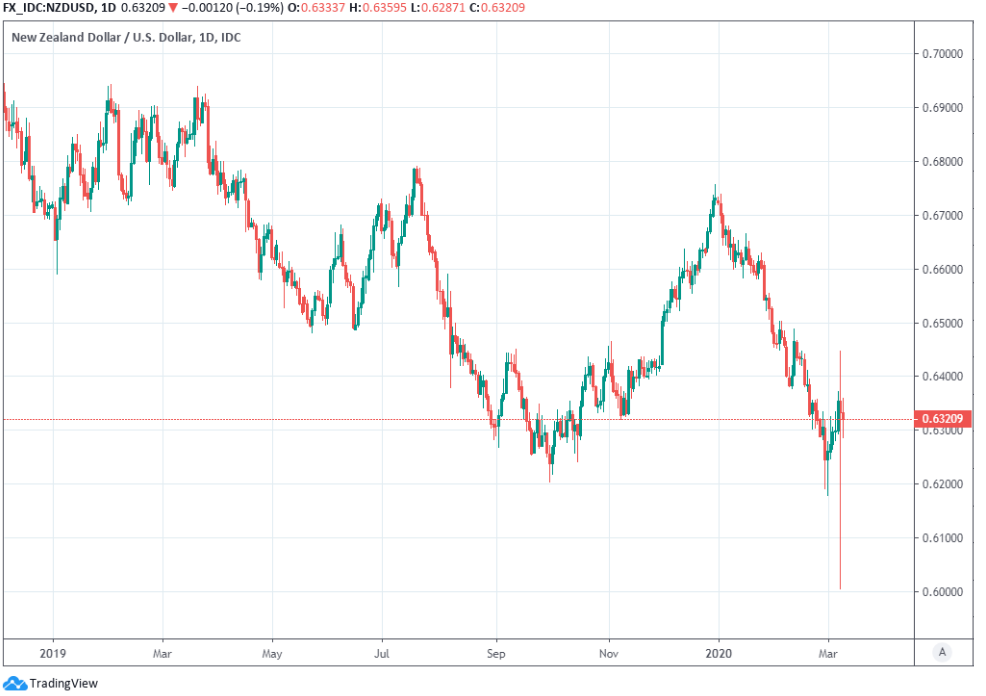Pound-to-New Zealand Dollar Rate Sets Sights on May 2016 High amid Coronavirus Panic
- Written by: James Skinner
-
- GBP/NZD tests new post-referendum high above 2.18.
- GBP has eyes on 2.1899 May 2016 peak as next target.
- But must overcome 2.0699 on a daily closing basis first.
- RBC forecasts GBP/NZD retreat back to 2.03 and 2.01.
- Price action comes after RBNZ eyes negative rates, QE.
- As investors price coronavirus wound to global economy.
- Details of NZ Gov stimulus package expected Thursday.

Image © Adobe Stock
- GBP/NZD Spot Rate: 2.0704, up +0.37% today
- Indicative bank rates for transfers: 1.9981-2.0126
- Indicative broker rates for transfers: 2.0395-2.0520 >> find out more about this rate.
The Pound-to-New Zealand Dollar rate has reached its highest level since before the Brexit referendum amid market panic over the global economic impact of coronavirus and it could now be on course for a return to May 2016 highs close to 2.20.
Pound Sterling has weakened against many major rivals as investors’ concerns about the coronavirus blow to the global economy have grown but it's risen 1.4% against New Zealand’s Dollar in the last week as commodity prices tumbled and global equity markets moved into ‘bear market’ territory.
The Pound-to-New Zealand Dollar rate retained an upside bias after it rose briefly to the 2.18 level in the prior session, as oil prices fell close to 30% and stock markets suffered their worst losses since the Eurozone debt crisis in response to the Italian government decision to quarantine a quarter of its population, a decision that’s since been extended to include all of Italy.
“Orr said that the first step to “unconventional” policy would be negative interest rates. Other measures include forward guidance, interest rate swaps and large scale asset purchases,” says Kim Mundy, a strategist at Commonwealth Bank of Australia. “Our ASB colleagues now expect no economic growth in H1 2020, with risks skewed towards NZ falling into recession.”
The Kiwi was on the back foot Tuesday as investors responded to Reserve Bank of New Zealand (RBNZ) Adrian Orr, who said overnight the bank would turn to negative interest rates and quantitative easing in order to support the economy through any coronavirus induced downturn. Markets already assign a 90% probability to the prospect of a large RBNZ rate cut that takes the cash rate from 1% to a new record low of 0.5% on Wednesday, 25 March.
Above: Pound-to-New Zealand Dollar rate shown at daily intervals. Testing 78.6% retracement of the May 2016 downtrend.
The Pound-to-Kiwi rate is now knocking on the door of the 78.6% retracement of the May 2016 downtrend at 2.0697, which will need to be overcome on a daily closing basis for the British currency to then have a clear path ahead of it back toward the May 2016 peak of 2.1882. But a failure to achieve a daily close above 2.0697 could trigger a downward correction in the exchange rate.
Analysts anticipate the coronavirus threat to the global economy will grow larger in the short-term, which could be enough to get the exchange rate sustainably across the 2.0697 level and on a path to 2.1882 given that a global downturn would likely weigh heavier on the Kiwi than Pound Sterling. However, some say the downside should be limited for the Kiwi from here, and are looking for the Pound-to-Kiwi rate to retreat back toward the 2.03 level in the weeks ahead.
“We still think the hurdle is high for the RBNZ to ‘out-dove’ the market. New Zealand is widely expected to be hit hard by the slowdown in tourism but its travel ban on certain foreign travelers has limited the domestic spread of the virus to five cases so far,” says Adam Cole, chief FX strategist at RBC Capital Markets. “On the fiscal side, FinMin Roberston has said a package is being prepared to deal with the virus impact.”
Above: Pound-to-New Zealand Dollar rate shown at weekly intervals. Testing 78.6% retracement of the May 2016 downtrend.
Cole says the RBNZ’s likely response to coronavirus is already in the price of the Kiwi and that the government’s bans on travel from some affected countries should limit the domestic outbreak of the deadly viral form of pneumonia. And with the government expected to announce fiscal support measures for Kiwi companies and households on Thursday, the day after the UK, the Kiwi could draw a supportive bid from the market in the latter part of the week.
“Technically, NZD/USD has pierced downtrend resistance at 0.6411 which has kick-started a bullish trend reversal (targets 0.6488 and 0.6523),” Cole says.
RBC forecasts the Pound-to-New Zealand Dollar rate will retreat back to 2.03 before month-end as the Kiwi rises a fraction against the U.S. Dollar and the Pound retreats back to the 1.30 level against the greenback. It also forecasts the exchange rate will dip back to 2.01 by year-end as the Brexit process weighs on the British currency, although price action in the exchange rate might be driven more by investors risk appetite and the relative spread of coronavirus in the two countries in the short-term.
Risk assets like stocks and oil underwent what some described as a “dead cat bounce” on Tuesday after President Donald Trump promised “very substantial relief” to companies and households as they grapple with a possible epidemic in the U.S., where infection numbers could rise this week after more than 4 million testing kits were delivered to state authorities following a scramble to manufacture sufficient numbers in wake of an earlier supply dearth.
Above: NZD/USD rate shown at dailyintervals.
“The number of new cases has been slowing notably in both China and Korea. While a third wave of infections centered around Europe ex-Italy and the US is barely in its take-off stage there are grounds for thinking that lockdowns and an aggressive testing profile can stem the tide,” says Richard Franulovich, head of FX strategy at Westpac.
Markets appeared optimistic the coronavirus crisis can be navigated by policymakers without too much bloodshed but Italy’s entire economy is now under a China-style lockdown in which movement is restricted and public gatherings are banned. And some are contemplating whether such measures will eventually be seen elsewhere in Europe, not to mention the U.S.
Efforts by government and the public to contain the virus, which is now spreading in the more than half the countries across the globe, are expected to deal a severe blow to the global economy in the first and second quarters, although much about the final cost will be determined by the pace of its spread through Europe and the U.S. over the coming weeks.
The Pound-to-New Zealand Dollar rate can be expected to rise in times of coronavirus related risk aversion unless the United Kingdom, where confirmed cases have risen from the low double digits to more than 300 in the last week, becomes the subject of the headlines.













